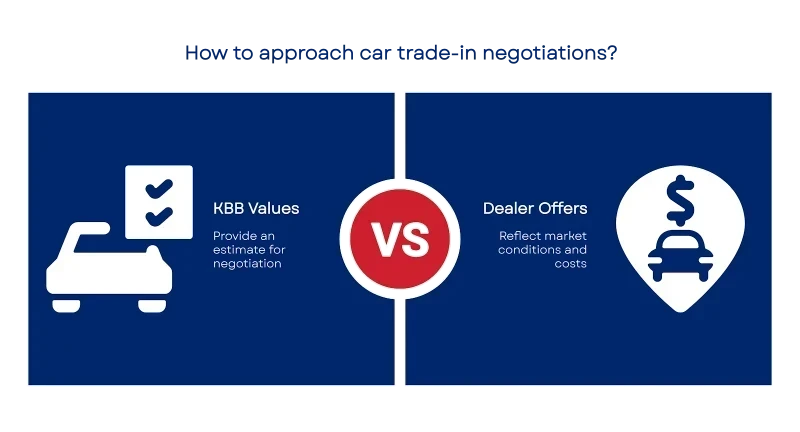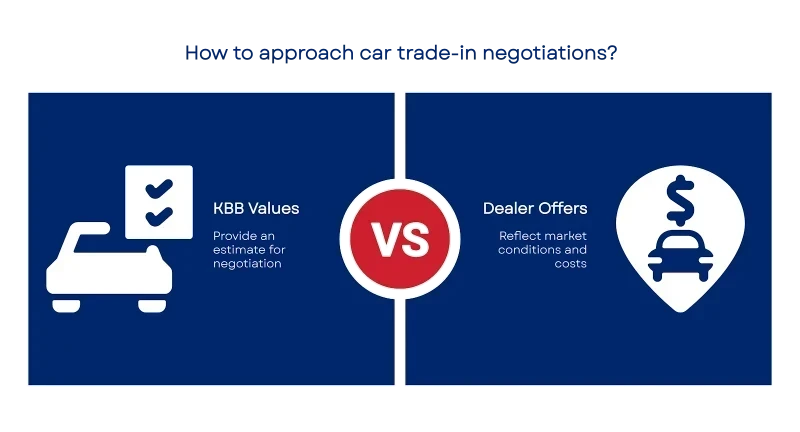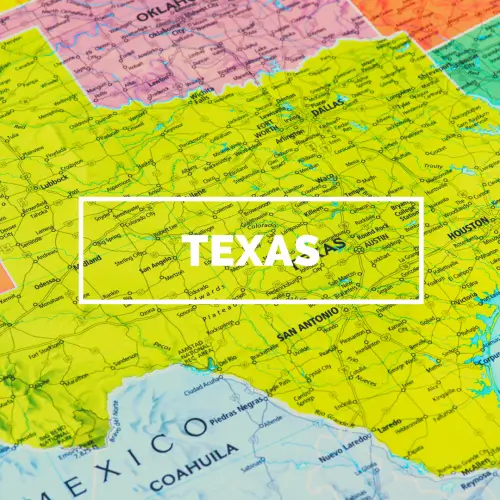KBB trade-in values are not exact, but they provide a solid estimate to start negotiations.
Many car owners are surprised when a dealer’s trade-in offer is lower than the number they saw on Kelley Blue Book. That happens because KBB values are based on averages and estimates, not firm offers. The actual amount a dealer is willing to pay depends on factors such as your car’s exact condition, the prices similar vehicles are selling for in your area, and the cost of preparing it for resale.
This article explains how accurate KBB trade-in values are, why dealer offers may differ, and what steps you can take to get the best possible deal.
What You’ll Learn
By the end of this article, you’ll have clear answers to the most common questions about Kelley Blue Book trade-in values:
How accurate is the KBB trade-in value compared to real dealer offers?
Why do dealers often provide less than the KBB value?
What steps can you take to maximize the value of your trade-in?
Summary
Kelley Blue Book (KBB) is one of the most recognized names in car valuation, but how accurate are its trade-in values in the real world? Here’s a comprehensive look at the facts, industry insights, and what car owners should know before relying on KBB for trade-in estimates.
How KBB Calculates Trade-In Value
Data Sources: KBB utilizes a vast database of actual sales transactions, auction prices, dealer sales, and private-party sales. These are analyzed and adjusted for local market conditions, seasonal fluctuations, and prevailing trends.
Frequent Updates: Values are updated at least weekly to reflect current market conditions in over 100 geographic regions.
Vehicle-specific factors, including year, make, model, mileage, condition, installed features, and regional demand, all influence the estimate.
KBB Trade-In Value: Strengths
Industry Standard: KBB is widely trusted and referenced by both consumers and dealers for its transparency and data-driven approach.
Negotiation Tool: Knowing your KBB trade-in value gives you leverage when negotiating with dealers.
Instant Cash Offer: KBB offers an Instant Cash Offer tool, providing a genuine, redeemable offer at participating dealerships, valid for seven days pending a successful inspection.
Limitations and Real-World Accuracy
Estimates, Not Guarantees: KBB values are best viewed as educated estimates, not guaranteed prices. Actual dealer offers may vary due to reconditioning requirements, local market demand, and dealer profit margins.
Dealer Practices: Dealers often use KBB to anchor negotiations, but may offer less, citing their appraisal tools (like Black Book, MMR, or JD Power) and local market comparables.
Condition Overestimation: Many owners overrate their car’s condition. KBB’s “Excellent” rating applies to only about 3% of vehicles; most cars are “Good” or “Very Good” at best.
Market Lag: KBB’s data can lag behind rapidly changing market trends, particularly during periods of significant price fluctuations or regional demand surges.
Private Sale vs. Trade-In: KBB’s trade-in value is typically lower than private party value, as it accounts for dealer profit and reconditioning costs. Private sellers often get more than KBB’s estimate, especially for in-demand vehicles.
What Impacts KBB’s Accuracy?
Expert and Consumer Insights
KBB is a solid starting point, but always compare it with other sources, such as Edmunds, NADA Guides, and real-time dealer offers.
Dealers may use KBB to justify lower offers, but you can often negotiate or get higher offers from online retailers like CarMax or Carvana.
For the most accurate value, use KBB’s Instant Cash Offer and compare it with multiple dealer and online offers before making a decision.
Key Takeaways
KBB trade-in values are generally reliable as a baseline, but not always a reflection of the highest possible offer you can get.
Expect dealer offers to be at or below KBB’s trade-in value, especially after accounting for reconditioning and profit margins.
Shop around: Get multiple offers and use KBB as a reference, not a final answer.
Condition and local demand matter: Be honest about your car’s condition and check local listings for similar vehicles to gauge real market value.
In summary, KBB trade-in values are a trusted and valuable tool, but should be used as a starting point. Always verify with real offers and consider market dynamics for the most accurate picture.
Why KBB Is Only A Starting Point
Kelley Blue Book trade-in values work a lot like a home appraisal. They give you an estimate based on market data, but the actual sale price depends on what buyers are willing to pay in your area at that moment.
Understanding this difference helps you avoid surprises at the dealership and puts you in a stronger position when it’s time to negotiate.
How KBB Calculates Trade-In Value
Kelley Blue Book bases its trade-in estimates on actual sales data from multiple sources:
Dealer sales: Transactions between dealers and retail customers.
Auction results: Wholesale prices from dealer auctions.
Private party sales: Reported prices from individuals selling to other individuals.
After collecting this data, KBB adjusts the figures to reflect your local market. Regional demand, supply, and seasonal trends all contribute to shaping the estimate you see online.
KBB updates its trade-in values at least once per week to account for market changes. However, the result remains an estimate and not a firm offer. A dealer’s appraisal can differ depending on your vehicle’s condition and other factors.
Strengths Of KBB Trade-In Value
Trusted industry benchmark
Kelley Blue Book is one of the oldest and most widely recognized names in vehicle valuation. Its trade-in values have become a common language between consumers and dealers.
When you bring a KBB estimate into a dealership, the staff will usually be familiar with it and know how it was calculated. That shared understanding can help set the tone for a more productive conversation.
Transparent and data-driven
KBB collects and analyzes data from multiple verified sources, including dealer retail sales, wholesale auction prices, and private party transactions. This information is combined and adjusted to account for regional demand, vehicle type, and the time of year.
The process is systematic and based on observed sales, which ensures consistent values grounded in actual market activity.
Regular updates to reflect market trends
KBB updates its trade-in values at least weekly. It makes the information more current than many printed guides or static resources. While markets can shift quickly, these updates reduce the risk of relying on outdated information when preparing to sell or trade.
Useful as a negotiating reference
Having a KBB trade-in estimate gives you a documented starting point for discussions. Even if a dealer disagrees with the exact figure, you can use it to question offers that seem unusually low. It also helps you explain why you believe your car is worth more if a dealer undervalues it.
Instant Cash Offer provides added certainty
KBB offers an Instant Cash Offer through its website and participating dealers. It is a genuine offer, contingent on inspection, that you can accept within a set time frame.
It removes some of the uncertainty associated with the standard estimate, as you know exactly how much a specific dealer is willing to pay under current conditions.
Why Dealer Offers May Differ From KBB Trade-In Value
KBB trade-in values are estimates based on market averages, but several real-world factors influence what a dealer is willing to pay.
Dealer costs and profit margins: Dealers subtract expected costs for repairs, cleaning, inspections, and transportation. They also include a profit margin and adjust for the expected demand for your car. These adjustments often result in an offer lower than the KBB estimate.
Vehicle condition: KBB requires you to select a condition category when estimating the value. Most people choose “Excellent,” but only about three percent of vehicles qualify. Overrating the condition inflates the estimate, making dealer offers seem lower by comparison.
Local demand: Some vehicles sell faster in certain regions than others. KBB adjusts for regional trends, but these trends can change quickly. Dealers adapt their offers to match what they believe the car will sell for locally.
Market timing: Prices can shift quickly due to changes in fuel costs, seasonal demand, or inventory shortages. KBB updates its data weekly, but these updates can lag behind rapidly changing conditions.
Features and upgrades: Factory-installed options are factored into KBB estimates, but aftermarket upgrades may not add value for a dealer. Customizations can even lower appeal if they do not match most buyers’ preferences.
Dealer appraisal tools: Many dealers utilize their systems, such as Black Book, Manheim, or JD Power. These tools may interpret data differently, which can lead to higher or lower offers than the KBB estimate.
Private sale comparison: KBB trade-in values account for dealer overhead and resale costs. Private sales typically command a higher price because these costs are not included.
These factors explain why the number you see on KBB is often higher than the offer you receive at a dealership. Using KBB as a reference point, rather than a final answer, helps you prepare for more realistic discussions.
For high-value or specialty vehicles, consider learning more about our enclosed auto transport service, which provides added protection during shipment.
How To Use KBB The Right Way: Step By Step
Step 1: Get your KBB estimate
Start by entering your vehicle’s details on Kelley Blue Book. Select the correct condition based on honest assessment. Use this number as a general reference, not a promised amount.
Step 2: Check other valuation sources
Look up trade-in values on Edmunds and NADA Guides. Each tool uses slightly different data. Comparing them gives you a better sense of what your car is worth.
Step 3: Request a KBB Instant Cash Offer
On the KBB website, you can generate an Instant Cash Offer redeemable at participating dealerships. It is a firm offer if your car’s condition matches your description.
Step 4: Get multiple offers
Visit several dealerships in your area. Contact online buyers like CarMax and Carvana for written offers. More offers give you options and strengthen your negotiating position.
Step 5: Review local market listings
Search local online listings for vehicles similar to yours. Pay attention to mileage, features, and condition. It helps you understand what buyers are paying in your area.
For a step-by-step explanation of moving your vehicle across state lines, read our guide on how to ship your car to another state.
Final Thoughts
Kelley Blue Book is a trusted resource for understanding your car’s trade-in value, but it is only one part of the process. The estimate you see online is a starting point. Dealers base their offers on real-time market conditions, the actual condition of the vehicle, and their costs.
You can get the best outcome by being realistic about your car’s condition, comparing multiple offers, and using KBB as a reference instead of a guarantee. Taking the time to research and shop around helps you make a more informed decision and ensures you get a fair price for your trade-in.
If this is your first time arranging transport, you can also check out our essential guide for first-time car shipping to better understand the process.
Need Help Shipping Your Car?
If you’re planning to trade in your vehicle and need it transported to a dealer or buyer, we can help. AmeriFreight Auto Transport specializes in safe and reliable vehicle shipping across the United States. We work with trusted carriers to match you with the best option for your route and timeline.
Contact AmeriFreight today to request an estimate and schedule your shipment. We are here to make the process straightforward and stress-free.
Frequently Asked Questions (FAQs)
What is the difference between fair market value and KBB?
Fair market value is the price at which a buyer and seller agree in an open market, based on the balance of supply and demand. Kelley Blue Book provides an estimated range based on recent sales data, adjusted for condition and location. KBB is a tool to help you understand fair market value, but it is not the same as an actual sale price.
How does KBB get its values?
KBB collects data from dealer retail sales, wholesale auctions, and private party transactions. They analyze this data and adjust it for regional trends, seasonal shifts, and current market conditions to calculate estimated values.
Are used cars selling above KBB?
In some cases, yes. During periods of high demand or low supply, some used cars sell for more than KBB’s estimate. This occurs because KBB values are updated weekly, whereas local markets can change more frequently.
How often do KBB values change?
KBB updates its values at least once per week. It keeps their estimates reasonably current, but they may still lag behind sudden changes in market demand or supply.
Disclaimer: The information in this article is for general guidance only and should not be considered financial, legal, or professional advice. Always consult with a qualified professional or dealership representative before making decisions about selling, trading, or valuing your vehicle.
















